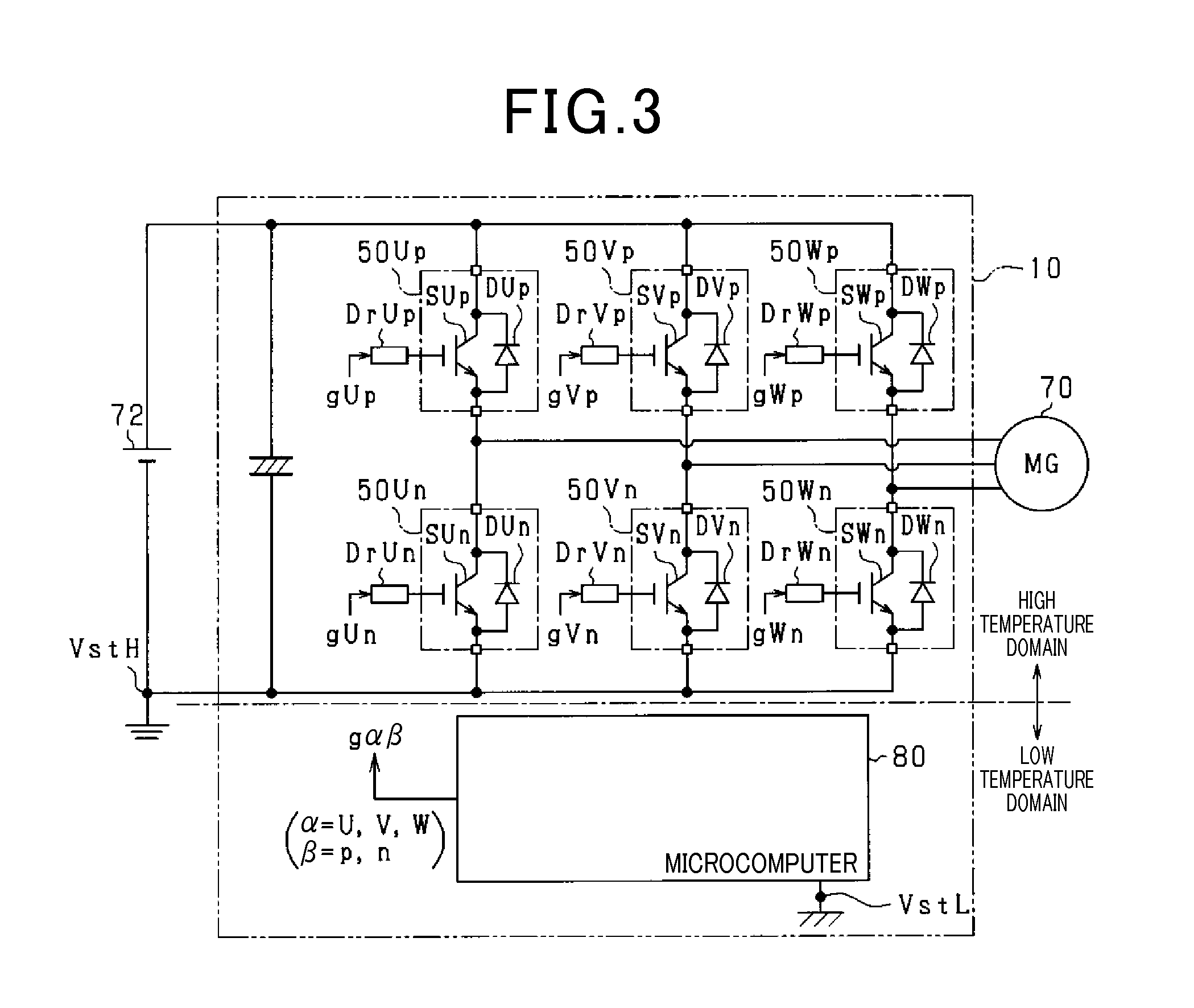Apparatus for detecting temperature of semiconductor elements for power conversion
a technology of power conversion and apparatus, which is applied in the direction of dc-ac conversion without reversal, heat measurement, instruments, etc., can solve the problems of enlargement of the temperature range of the restricted use of the switching element, inability to reliably protect the switching element from overheating, and inability to perform overheat protection processes. , to achieve the effect of preventing the semiconductor element from overheating, preventing enlargement of the temperature range, and restricting
- Summary
- Abstract
- Description
- Claims
- Application Information
AI Technical Summary
Benefits of technology
Problems solved by technology
Method used
Image
Examples
first embodiment
[0032]There will now be explained a temperature detection apparatus applied to a vehicle-mounted power converter (a three-phase inverter) in accordance with a first embodiment of the present invention with reference to the accompanying drawings.
[0033]The three-phase inverter of the first embodiment will be explained with reference to FIGS. 1 and 2.
[0034]As shown in FIGS. 1 and 2, the three-phase inverter 10 includes a circuit board 20, a cooler 30, a frame 40, U-, V-, W-phase upper-arm semiconductor modules 50Up, 50Vp, 50Wp, and U-, V-, W-phase lower-arm semiconductor modules 50Un, 50Vn, 50Wn.
[0035]Each semiconductor module 50αβ (α=U, V, W: β=p, n) is a member, into which a switching element, a freewheel diode electrically connected in anti-parallel with the switching element, and a temperature-sensitive diode for detecting a temperature of the switching element are modularized. In the present embodiment, an insulated gate bipolar transistors (IGBT) is used as the switching element....
second embodiment
[0078]There will now be explained a second embodiment of the present invention. Only differences of the second embodiment from the first embodiment will be explained with reference to the accompanying drawings.
[0079]As shown in FIG. 6, the microcomputer 80 of the present embodiment includes first to sixth input ports t1-t6. The first to third input ports T1, T2, T3 are electrically connected directly to outputs of the U-, V-, W-phase upper-arm photocouplers CUp, CVp, CWp via U-, V-, W-phase upper-arm electrical paths LUp, LVp, LWp. Fourth to sixth input ports T4, T5, T6 of the microcomputer 80 are electrically connected directly to outputs of the U-, V-, W-phase lower-arm photocouplers CUn, CVn, CWn via U-, V-, W-phase lower-arm electrical paths LUn, LVn, LWn. In the present embodiment, the α-phase upper- and lower-arm electrical paths Lαp, Lαn (α=U, V, W) may use the wiring pattern of the circuit board 20.
[0080]The present embodiment described above can also prevent each of the six...
third embodiment
[0081]There will now be explained a third embodiment of the present invention. Only differences of the third embodiment from the first embodiment will be explained with reference to the accompanying drawings. In the present embodiment, a two-motor control system including two motor generators (rotating electric machines) is used as a control system. More specifically, as shown in FIG. 7, the control system includes an buck-boost converter 90, a first inverter 100, a first motor generator 101, a second inverter 102, a second motor generator 103, and a microcomputer 80. Each of the motor generators 101, 103 may be a permanent magnet synchronous electrical motor. Elements having similar functions as in the first embodiment (see FIG. 1) are assigned the same numbers.
[0082]The buck-boost converter 90 includes an input capacitor 91, a reactor 92, voltage-transformation switching elements SCpa, SCpb, SCna, SCnb, freewheel diodes DCpa, DCpb, DCna, DCnb electrically connected in anti-paralle...
PUM
| Property | Measurement | Unit |
|---|---|---|
| threshold temperature Tγ | aaaaa | aaaaa |
| threshold temperature Tγ | aaaaa | aaaaa |
| threshold temperature Tγ | aaaaa | aaaaa |
Abstract
Description
Claims
Application Information
 Login to View More
Login to View More - R&D
- Intellectual Property
- Life Sciences
- Materials
- Tech Scout
- Unparalleled Data Quality
- Higher Quality Content
- 60% Fewer Hallucinations
Browse by: Latest US Patents, China's latest patents, Technical Efficacy Thesaurus, Application Domain, Technology Topic, Popular Technical Reports.
© 2025 PatSnap. All rights reserved.Legal|Privacy policy|Modern Slavery Act Transparency Statement|Sitemap|About US| Contact US: help@patsnap.com



